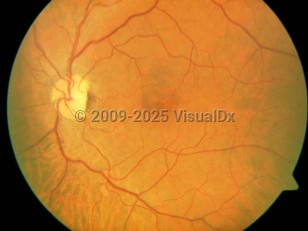Central retinal artery occlusion - External and Internal Eye
Alerts and Notices
Important News & Links
Synopsis

With acute blockage of blood flow through the central retinal artery, profound vision loss ensues. A patient typically presents with sudden unilateral painless vision loss. There may be a history of amaurosis fugax in 10% of patients.
Embolism is the most common cause of CRAO, usually originating from the carotid arteries or the heart. Other causes include inflammation (including giant cell arteritis), vessel spasm, thrombosis, hypercoagulable state, hypertensive retinal necrosis, increased intraocular pressure, hemorrhage under an atherosclerotic plaque, and dissecting aneurysm within the central retinal artery.
Without intervention, a CRAO will lead to blindness in the affected eye. Experimental studies have shown that after only 4 hours, an obstruction of the central retinal artery can result in massive irreversible cell death and retinal necrosis. Even with immediate treatment, the prognosis is poor, with only 21% to 35% of eyes retaining useful vision. Most of those who recover useful vision have a cilioretinal artery that preserves the central macula function.
Codes
H34.10 – Central retinal artery occlusion, unspecified eye
SNOMEDCT:
38742007 – Central retinal artery occlusion
Look For
Subscription Required
Diagnostic Pearls
Subscription Required
Differential Diagnosis & Pitfalls

Subscription Required
Best Tests
Subscription Required
Management Pearls
Subscription Required
Therapy
Subscription Required
Drug Reaction Data
Subscription Required
References
Subscription Required

